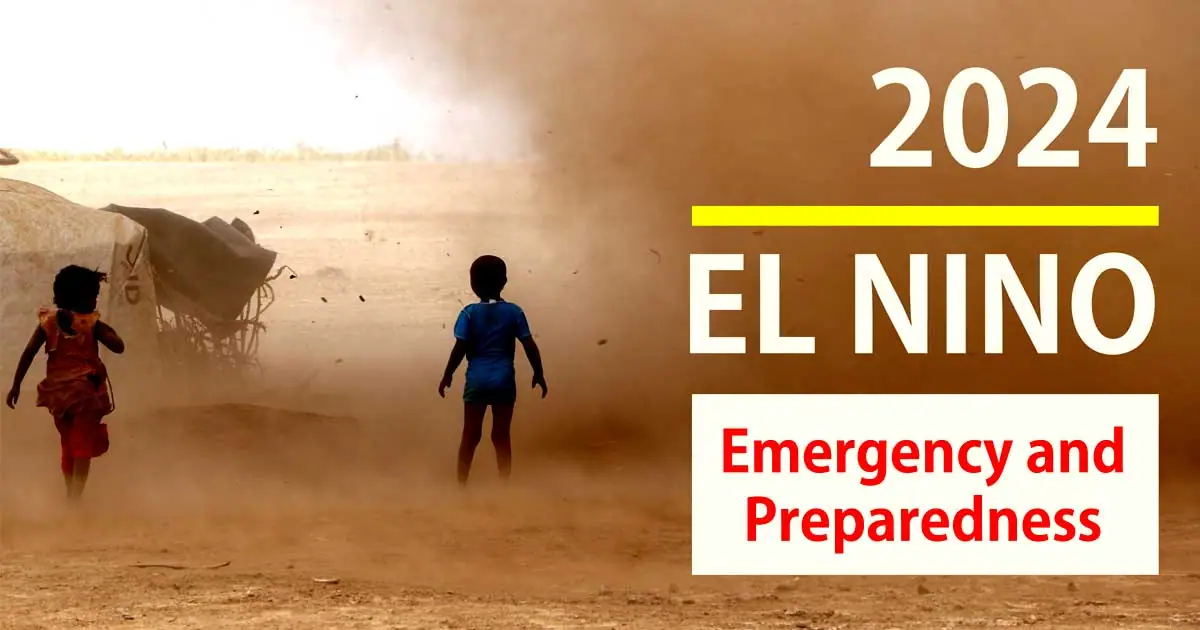Climate change is the biggest topic of discussion in the world today. Various activities, various initiatives, and awareness campaigns are going on in the country. On the contrary, it is time to check how true or false our equation of reality is. El Niño is the future of climate change.
El Nino is not only a climate problem but also a global challenge. Bangladesh is not left out of this challenge. El Nino can harm us? Are we ready to face this challenge?
What is El Nino
El Nino literally means little boy. But in reality, it does not mean any boy or girl. It is the name of a natural weather condition. Generally, sudden warming of seawater is called El Nino and sudden cooling is called El Nina.
Pacific trade winds normally flow from east to west. This causes water to flow from South America towards Asia. So if the water in the western ocean warms, the flow of warm water will increase in the Asian region, which is basically known as El Nino.
El Niño is a bifurcation of a weather pattern called the Southern Oscillation (ENSO), which is an erratic but periodic change in wind patterns and sea surface temperatures over the tropical eastern Pacific Ocean. El Niño refers to the warming phase of the ENSO. La Nina on the other hand refers to its cooling phase.
Westerly winds are always weak during El Nino. Air pressure and wind direction are constantly changing. This causes warm surface water to flow along the equator from the western Pacific to the coast of North and South America. Then the excess of hot water is so great that the cold water has no effect. Because of this, the waters of the central and eastern Pacific Oceans are unusually warm, and this affects the normal pattern of the atmosphere.
The most significant of these changes is the negative impact on the weather in Asia. Rainfall in the Indian subcontinent may decrease significantly under the influence of El Nino. Experts fear that the temperature will be much higher, and as a result, drought and fires may occur.
El Niño occurs on average every three to five years and varies in strength, according to the US National Oceanic and Atmospheric Administration. The characteristics of one El Nino are not identical to another. The last strong El Niño was in 2016. In that year, the average temperature on Earth was felt to be the highest.
What is the scientific reality of El Niño?
In fact, El Nino means warm ocean currents in the Pacific Ocean. These currents warm the waters off the west coast of South America, especially towards Peru. At this time, the flow or direction of tropical air in the southern hemisphere changes.
Most commonly, the southern hemisphere’s monsoon winds blow towards Australia. However, under the influence of El Nino, this airflow is not normal. Sometimes the speed decreases, and sometimes the direction of the wind reverses. The wind then blows from east to west.
As a result, the water that is supposed to go to Australia goes to Peru, that is, to the west coast of South America. Due to Australian water moving towards Peru, the water temperature and height on the coast of Australia decrease which increases towards Peru.
Fluid transfer can occur in three ways. Transport, convection, and radiation. Like water, air is a fluid. And when the wind moves upward, it takes the seawater with it. Delivers to the atmosphere. This water condenses at high pressure in the atmosphere, thereby lowering the temperature. Once it rained. That is, the rain that should normally occur in Australia, occurs in Peru.
But what is the relationship between Bangladesh and El Nino? El Niño will affect Bangladesh, why? During El Nino, when the tropical winds blow west rather than east, the entire region—from Australia to Bangladesh, India, and Myanmar—decreases rainfall. Because the wind flow tends to carry the sea current towards the west. As a result, rain increases towards the west. From Bangladesh, India, and Myanmar to Australia – these regions experience a lack of rain. The temperature rises. The soil dries up. Even drought can occur.
When did El Niño first appear?
About the 16th century. The place was on the west coast of South America. A group of fishermen were fishing that day as usual. Suddenly they felt that the sea water was much hotter than usual. The water in this region is usually very normal or cold. They did not think of any reason for this. They termed this unusual situation as ‘El Nino de Navidad’.
The English word ‘Navidad’ means Christmas. They named it so because it was Christmas time. Since then, several times in a row, they saw such an event in the sea, which happens only during Christmas, that is, in December. Later, the research scientists showed that El Nino can occur not only in December but also in April-May.
El Niño Research and Forecasting
Scientists believe El has been forming for thousands of years. Scientists evaluate the social condition of modern Peru as the biggest example of this. Peru has been affected by El Niño for thousands of years. Scientists discovered the existence of El Niño by analyzing warm sea surface temperatures and chemical precipitation caused by El Niño in coral samples that are about 13,000 years old.
The first written record of El Niño was found in a writing by Francisco Pizarro in 1525. He was the first to mention rainfall in the Peruvian desert in his writings. Later, in modern research, scientists found El Nino occurring since 1900. In the last 100 years, 26 El Niños have been observed. Among the 26, the worst and strongest El Nino occurred in 1982-83, 1997-98 and 2014-16.
Since El Nino is a regular occurrence nowadays, almost all the affected countries have pre-preparedness and forecasting systems. It is not known about such a system in Bangladesh, but in other countries, research is also done on El Nino.
The Australian Bureau of Meteorology assesses the sea surface temperature in Niño 3 and 3.4 zones, taking into account trade winds, Southern Hemisphere temperature conditions, meteorological conditions, etc. before declaring El Niño. The United States Climate Prediction Center (CPC) and the International Research Institute for Climate and Society (IRI) predict sea surface temperatures in the Niño 3.4 region, assuming conditions in the tropical Pacific Ocean to be 0.5 °C higher or lower than NOAA’s Oceanic Niño Index. Can the Japan Meteorological Agency decide on El Niño by evaluating the 5-6 month sea surface temperature of the Niño 3 region?
Similarly, the Peruvian government decides on El Niño by evaluating the 3-month sea surface temperature of Niño 1 and 2 regions. The temperature variation during this period can be a maximum of 0.4 °C. If it is more than that, the government can declare El Nino.
What can be the effect of El Nino?
There is no doubt that hostile weather will prevail in areas affected by El Nino. Scientists believe that in 2024, not only El Niño-affected areas, but almost all regions of the world may experience an abnormal increase in temperature. At this time, the production capacity of hydropower may decrease. Because of that, a power crisis may occur. Air conditioning usage will increase, and load shedding will also increase.
Meteorologists and climate scientists believe that El Nino may have adverse effects on Australia. Drought or fire may occur due to more dryness and increased temperature. Its impact is no less harmful for India and Bangladesh. At this time, the amount of rainfall can decrease significantly. As a result, agricultural production will decrease.
As agricultural production declines, regional food security risks will naturally increase to a large extent. And the biggest correlation with this is the economy that can collapse. If the food crisis increases, inflation will increase at the same time. It will reduce the purchasing power of people.
Moreover, due to an increase in abnormal temperature, the occurrence of natural disasters like cyclones, cyclones, flash floods, and tidal waves will increase more than before. This will severely disrupt coastal life and increase the government’s post-disaster response costs.
El Nino affects the weather around the world. During this time the normal weather patterns of the whole world changed. As a result, severe drought in many places and heavy rains in some places.
Most tropical cyclones under the influence of El Niño form along the subtropical ridge near the equator. Later it changes course back to the main westerly belt which gradually moves towards the polar region.
On the other hand, in the Atlantic Ocean, vertical wind direction changes increase during this time, which inhibits the intensity of tropical cyclones. At the same time, the westerly wind is very strong.
Regional influence
As El Nino is a global weather phenomenon affecting the global climate, its impact is more or less felt in all countries. However, not all countries are equally affected. Some countries have less influence and some countries have more. The pattern and impact of El Niño varies from region to region.
An observation of El Niño events since 1950 shows that the effects associated with El Niño events depend on the time of year. Scientists and experts can only guess what will happen or what could happen as a result of El Niño and cannot say anything with certainty.
Africa
March in various African countries like East Africa, Kenya, Tanzania
Long rains are likely from May to May. During this time the weather is more humid than usual. The south-central African countries of Zambia, Zimbabwe, Mozambique, and Botswana experience drier-than-normal weather from December to February during El Nino.
Antarctica
There are many ENSO (El Niño and the Southern Oscillation) connections to the high southern latitude regions around Antarctica. High-pressure variations occur in the Amundsen and Bellingshausen Seas during this time. This high-pressure variation leads to reduced sea ice and increased poleward heat flux. But in the Weddell Sea (part of the Southern Ocean) the opposite is the case. During El Nino, the water in this sea gets colder. But when La Nina (the opposite of El Niño) occurs, the Weddell Sea ice melts. Such a pattern of Antarctic weather under the influence of El Nino and La Nina is known as the Antarctic Dipole Mode.
Asia
Under the influence of El Nino, warm water spreads from the western Pacific and Indian oceans to the eastern Pacific. As a result, a severe drought occurred in the western Pacific region. On the other hand, the dry areas of the Pacific Ocean are prone to heavy rains.
In 2010, Singapore saw its first driest February since El Nino records began in 1869. Rainfall was only 6.3 mm and the highest temperature recorded at the end of the month was 35 °C.
El Nino and sustainable agriculture
El Niño forecasting tools for farmers can be radio, television, newspapers, or digital web. Regularly updated information on El Nino is available on various websites. Farmers also need to be a little smarter as time is pressing to save agriculture from the effects of El Nino. El Niño and sustainable agriculture are only simple for smart farmers. Farmers must be aware of El Niño in advance to maintain a regulated equation of El Niño and agricultural products.
What can farmers do to win El Niño?
- Wait for El Nino to pass
- Prepare for growing conditions characterized by high moisture levels.
- Harvest water
- Soil Management.
- Diversify your crops.
- Monitor Weather Forecasts and Stay Informed.
- Make long-term plans.
- Take care of your health.
- Assess Vulnerabilities.
- Improve Drainage Systems.
- Crop Selection and Rotation.
- Emergency Plans.
- Crop Insurance and Financing Planning.
How to prepare for El Nino in [your region]
The effects of El Niño are different in different regions of the world. How El Niño affects your area depends on your geographic location. Your area may experience high rainfall or drought. There must be advance preparation to deal with such situations. Below is a possible list of what to do if there is heavy rain:
El Nino and emergency preparedness
- Inspect and maintain roofs and gutters
- Upgrade drainage systems
- Secure windows and doors
- Maintain landscaping and property grounds
- Dealing with commercial water damage
- Responding quickly
- Remediating mold
- Eliminating liability concerns
El Nino, Bangladesh, and 2024
2024 is going to be the hottest year in the history of the world. As a country in the eastern and northern hemispheres, Bangladesh experienced a severe heat wave in May-June 2023. The country received 16 percent less rainfall than normal in June. We have already seen the impact of El Niño in Asian countries. Scientists believe that its effect will last from April to May this year.
We have already faced many natural calamities due to this. In the same year, Bangladesh, India, and Myanmar faced three cyclones Mokha, Hamun, and then Midhili. Moreover, the agriculture sector has been the most affected by the impact of El Nino in Bangladesh.
In addition, this cycle of El Niño coupled with the effects of global warming is expected to increase local drought and hunger as well as animal-borne diseases. Mosquito infestation will increase manifold. Experts believe that the dire situation of dengue this year will lead to a catastrophe if no action is taken now.
This year almost all types of crops including paddy may face problems. Crops may be burnt due to extreme heat or may be damaged by natural disasters. Many countries in South and East Asia have already prepared to stockpile and preserve crops. Indonesia plans to harvest early.
According to the National Strategy Paper on Internal Displacement Management of Bangladesh, about 4.7 million people were displaced due to natural disasters in the country from 2008-14. Experts fear that this number may reach one and a half crore by 2050. The United Nations children’s agency UNICEF also claims that the lives of about 20 million children are at risk.
The reality behind everything is the effect of El Niño in Bangladesh. The United Nations Meteorological Organization (WMO) says global temperatures could rise by 1.5 degrees by 2027. The government is already planning adaptation projects to mitigate the risks of climate change which, if implemented, may reduce some of the damage.
El Niño is a natural and meteorological phenomenon. People indeed have no control over it, but once there was. We are endangering the overall environment for our survival. Maybe never understand or not. Unplanned tree felling, carbon emission, unplanned housing growth, etc. have seriously damaged our environment.
If we had been more aware in advance, maybe disasters like El Nino would not have touched us. Even if it was possible, the intensity would not be so high. But we have nothing to do except to deal with the ongoing situation.
200 million people expect the adaptation project adopted by the government of agriculture-based Bangladesh to be implemented quickly to deal with El Nino to eliminate all risks including the safety of public life, and the safety of generations.
FAQ
Why is El Nino Dangerous For Bangladesh?
Bangladesh is south of the sea and El Nino is related to the sea so its impact on Bangladesh is very high. Also, since the easterly winds over the Pacific Ocean are weak, warm water flows back towards the Indian subcontinent. As a result, the climate of the region remains dry, which affects Bangladesh.
Can the rainfall in Bangladesh be affected by El Nino?
no There is no chance of rainfall in Bangladesh under the influence of El Nino. However, hurricanes, cyclones or any other type of sea-based natural disaster can occur. As the weather in this region will remain dry, there is a possibility of warming or intense heat and drought




